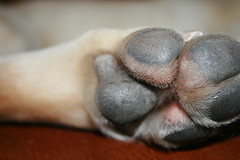One subject I would like to see come up more often when we discuss juvenile justice is the rehabilitative use of animals. I’ve written before about programs that bring in animals to socialize inmates and teach them responsibility, I think they are important.
Having to care for an animal provides emotional support at the same time it teaches discipline – both essential elements for getting kids out of the cyclical behavior patterns that keep them behind bars. The Austin Statesman reports on the program:
Dog and girl are part of a little-known pet adoption program that celebrates its third anniversary this month. PAWS, or Pairing Achievement with Service, operates entirely within the tall security fences at the Ron Jackson Juvenile Corrections Complex in this West Texas city.
Officials say the program, the only one like it in the Texas Juvenile Justice Department’s six lockups, so far has helped turn around the lives of 41 lawbreaking teen girls and saved 67 dogs from a likely fate of being euthanized.In all, eight offenders of the 97 at the state’s only lockup for girls participate in the 12-week therapeutic program that April Jameson, the facility’s interim superintendent, said has the lowest rates for misbehavior of any type. “We really don’t have any problems in the PAWS dorm,” she said.
Holli Fenton, a dog lover (she has six) who is the dorm supervisor and overseer of the program, said both the girls and the dogs are carefully screened for compatibility before they can participate. The dogs live in cages in each girl’s cell-like room, and the girls are responsible for feeding, grooming, exercising and training the canines for adoption. They even do a “re-entry” plan for their dog, Fenton said.
If the girls successfully complete the initial training program, they can ask to stay on as mentors to other girls.
‘We’re able to use a canine as an example for the girls,’ she said. ‘They have to have teamwork to accomplish things with the dog. They learn patience when they train it. They learn how to organize and redirect themselves.’
Any pet owner can tell you how much patience and discipline are involved in an animal’s care, traits that are vital for youth offenders to learn if they want to stay out of jail. Unlike many other programs designed to teach these traits, having an animal involved adds an element of emotional connection. The combination of the two makes for a potent tool. Just look at what the Texas Juvenile Justice Department says about the program on their website:
PAWS compliments CoNEXTions© because it teaches the youth empathy, compassion, responsibility, patience, accountability, and dependability. The relationships the youth form with their K9 companions help them develop skills that can be transferred to their relationships with others, thereby increasing their chances for success in the community.
Youth at TJJD have individualized case plans, with unique objectives. PAWS helps the youth achieve some of their objectives in creative ways ranging from youth researching their dog’s breed to writing autobiographies or community re-entry success plans for their dogs.
The TJJD therapeutic approach involves connecting youth with positive social forces and assets, drawing on community resources to engage youth, and engaging youth in pro-social activities and opportunities. PAWS is a natural fit.
Even if a reduction in dorm violence was the only benefit it would make this a program worthy of emulation, but it is not. Learning to care for a pet builds empathy, a trait often impaired in those whose upbringing has involved abuse, violence, or neglect. Forging a connection with another creature is the first step toward greater empathy for one’s fellows. It also introduces positive emotions and connections that have also probably been in short supply.
In addition to developing empathy and self esteem, the girls involved are also saving the lives of their four-footed companions. Each of the dogs involved faced a high probability of being euthanized before gaining a second chance through PAWS. From the canine perspective, as well as the human one, it is certainly a winning arrangement.
Related articles
- Big Country Journal: Girls doing time find a freedom with dog program (reporternews.com)
- PAWS gives detained girls a hand (mysanantonio.com)
- Juvenile offenders working with dogs: ‘God put me over here for a reason’ (mysanantonio.com)











